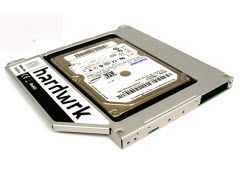How to boost your MacBook Pro performance

After the Build-Your-Own "Ultimate" Adobe Photoshop CS6 PC piece I wrote a few weeks ago I learned three things about Hardware 2.0 readers.
First, a lot of you use high-end pro Adobe products such as Photoshop and Premiere Pro, much more than I'd expected. Second, a lot of you work on portable systems, in particular Apple's MacBook Pro. And finally, those of you using MacBook Pro systems would like to know what you could do to make your shiny aluminum workhorse run even faster.
Because the MacBook Pro is a portable system, you can't crack it open and replace the CPU or graphics, so the upgrades that we can do are going to be limited. Nevertheless, there's a lot we can do to give this already fast machine a significant performance bump.
Performance boost your MacBook Pro
| Image Gallery: Performance boost your MacBook Pro |  | |||||
RAM
The most obvious upgrade is to add more RAM. All 2011 MacBook Pro models -- which include the early-2011 15-inch and 17-inch models, and the late-2011 13-inch and 15-inch models -- support up to 16GB of RAM in the form of an 8GB module in each of the two slots.The RAM you are looking to use is DDR3 PC3-10600, and a 16GB kit from a vendor like Crucial will set you back $160.
Bumping the RAM up to maximum is the single best performance upgrade that you can carry out.
RAM upgrades for the MacBook Pro systems are very straightforward, and detailed step-by-step guides for each of the MacBook Pro models can be found over on iFixit.
Storage
Another way to boost the performance of your MacBook Pro is to replace the hard disk drive, or HDD, with a much faster solid-state drive, or SSD.Depending on how much storage you're looking for, this upgrade can range from reasonable to very expensive. A 64GB SSD from Crucial is under $100, but a 512GB SSD is $600. For the best drive write speeds go for the 256GB or 512GB models, because both of these offer write speeds of 260MB/s.
Replacing the drive in a MacBook Pro isn't too difficult, but it does involve a little surgery. Again, if you want to know how to carry out this storage transplant then consult the excellent guides over on iFixit.
Special upgrade for the late-2011 13-inch MacBook Pro
If you own a late-2011 13-inch MacBook Pro then there's a special upgrade that only you can carry out.The model of MacBook Pro is unique in that both the hard drive and optical drive SATA ports both support high-speed SATA-III. This means that you can replace both the hard drive and the optical drive with two SSDs and configure them into an ultra-fast RAID-0 configuration.
To carry out this upgrade you will need two SSDs. If money doesn't mean anything to you then I recommend the 512GB Samsung 830 series drives, but at $849.99 each they're expensive, so feel free to go with something cheaper. Couple that with a SATA adapter kit that replaces the optical drive with an enclosure for a second drive, and you are good to go.
There are a number of kits out there that will allow you to install two drives into a MacBook Pro, but one of the best is made by German firm Hardwrk. With this kit, you also get an enclosure for the optical drive that allows it to be used as an external USB-DVD drive.
If you combine this upgrade with the RAM upgrade then you will be the proud owner of one of the fastest 13-inch MacBook Pro systems on the planet.
Remember that only the late-2011 13-inch MacBook Pro supports SATA-III speeds on the optical drive port. Carrying out this upgrade on any 15-inch or 17-inch MacBook Pro models, or an earlier 13-inch model, will be nothing more than a waste of money.
Image source: iFixit (1, 2), Hardwrk.
Related: